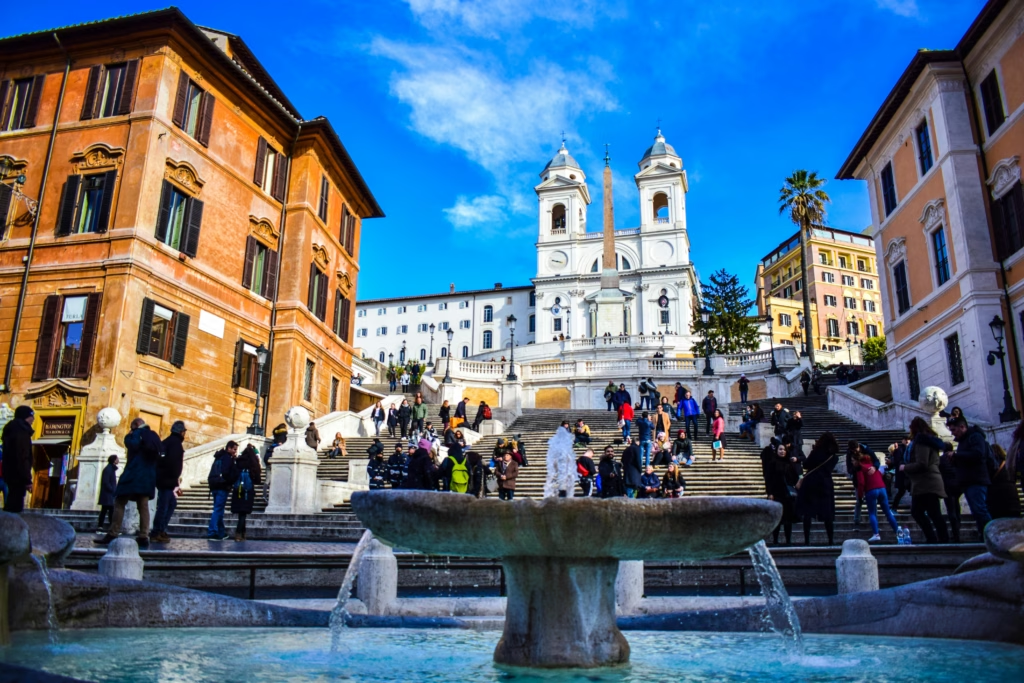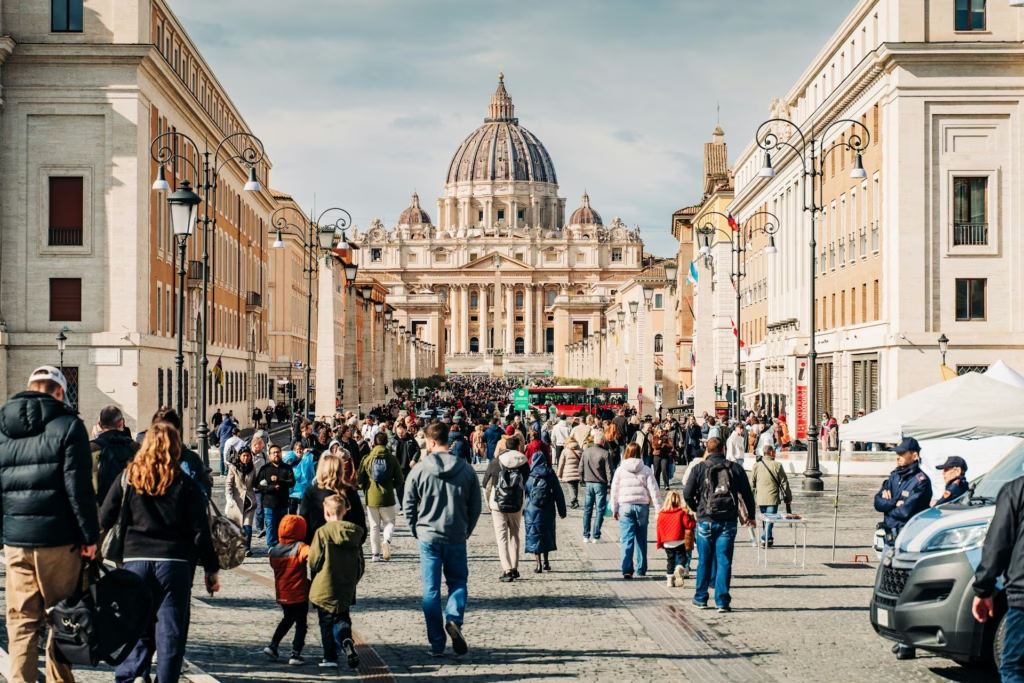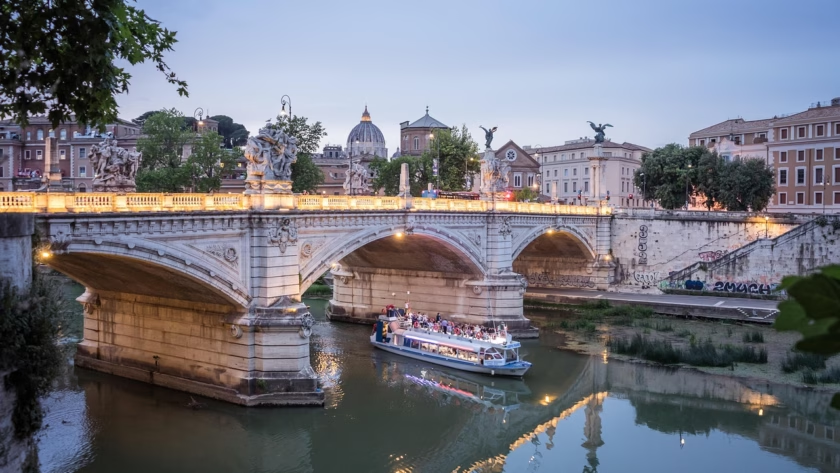Planning a trip to Rome in 2025 and wondering about the costs? With the special Jubilee Year bringing millions of additional visitors to the Eternal City, understanding Rome’s expenses is more important than ever. So is Rome expensive? Rome is moderately expensive compared to other European capitals, falling between the higher prices of Paris and London and the more affordable rates of Eastern European cities. A typical traveler will spend €54-122 per day as a backpacker, €128-222 for budget travel, €273-455 for mid-range comfort, and €585-1,335 for luxury experiences. During the 2025 Jubilee Year, expect prices to be 15-30% higher than normal, particularly for accommodation near the Vatican and city center.
While Rome isn’t cheap, it offers exceptional value with its unparalleled concentration of historical treasures, artistic masterpieces, and culinary delights. This guide breaks down all costs you’ll encounter in Rome during 2025, from accommodation and food to transportation and attractions, with practical money-saving strategies for every budget level.
Why is Rome So Expensive in 2025?

Rome’s costs in 2025 are influenced by several key factors:
The Jubilee Year Effect: The Catholic Church’s 2025 Jubilee Year (December 24, 2024 – January 6, 2026) is expected to bring an additional 15 million visitors to Rome, creating significant demand pressure on all services, especially accommodation near the Vatican and city center (30-50% price increases during peak periods).
Economic Factors: Italy’s high VAT rate (22%), strong Euro, post-pandemic recovery costs, and labor shortages are all contributing to higher prices.
Tourism Demand: Rome consistently ranks among the world’s most visited cities (9-10 million annual overnight visitors plus 15 million day-trippers), creating year-round demand pressure in a relatively small historic center.
Is Rome expensive to visit in 2025? Yes, particularly compared to previous years, due to the confluence of the Jubilee Year with post-pandemic tourism recovery and ongoing economic pressures. However, with strategic planning, Rome can still be enjoyed on various budget levels.
Accommodation Costs in Rome
Accommodation will likely be your largest expense in Rome, especially during the 2025 Jubilee Year when demand reaches unprecedented levels.
Hotel Prices by Category
| Hotel Category | Low Season (Jan-Feb, Nov) | Shoulder Season (Mar, Jul-Aug) | High Season (Apr-Jun, Sep-Oct) | Peak Jubilee Periods |
|---|---|---|---|---|
| 5-Star Luxury | €280-450 | €350-550 | €450-700 | €550-900 |
| 4-Star | €150-250 | €180-300 | €220-380 | €280-450 |
| 3-Star | €80-140 | €100-180 | €130-220 | €160-280 |
| 2-Star | €60-90 | €70-120 | €90-150 | €110-180 |
| 1-Star/Hostel | €25-60 | €35-70 | €45-90 | €55-110 |
Prices are per night in euros for a standard double room or hostel bed during 2025. Peak Jubilee periods include Christmas/New Year, Easter, and major religious celebrations.
Neighborhood Price Variations
Where you stay significantly impacts your accommodation costs:
Most Expensive Areas: Vatican/Prati, Historic Center/Centro Storico, Spanish Steps/Piazza di Spagna, Pantheon/Navona (€180-900/night)
Mid-Range Areas: Trastevere, Monti, Testaccio, Aventine Hill (10-35% cheaper than Centro Storico)
Budget-Friendly Areas: San Giovanni, Ostiense/Garbatella, Pigneto, Nomentano/Bologna (30-50% cheaper than central areas)
Alternative Accommodation Options
Apartment Rentals: €70-300/night depending on location, size, and amenities. Particularly good value for families or stays longer than 3 days.
Religious Guesthouses: €60-120/night for simple but clean accommodations, often in incredible historic buildings.
Hostels: €25-60/night for dorm beds, with private rooms from €70-120/night.
For travelers with early arrivals or late departures, Radical Storage offers convenient luggage storage locations throughout Rome, allowing you to maximize your sightseeing time without paying for an extra night’s accommodation.
Food and Dining Costs in Rome

Is Rome expensive to eat and drink? Food costs in Rome span a wide range, from budget street food to Michelin-starred experiences.
Restaurant Prices by Category
| Dining Category | Cost Per Person | What to Expect |
|---|---|---|
| Street Food | €5-10 | Pizza al taglio, supplì, sandwiches |
| Budget Trattorias | €15-25 | Simple pasta dishes, house wine, casual atmosphere |
| Mid-range Restaurants | €30-50 | Full meal with appetizer, main course, dessert, wine |
| High-end Dining | €70-120+ | Refined cuisine, extensive wine list, elegant setting |
Prices reflect 2025 rates and include service. During peak Jubilee periods, expect 10-15% higher prices and difficulty securing reservations without advance booking.
Typical Food and Drink Prices
| Item | Average Cost | Price Range | Notes |
|---|---|---|---|
| Espresso at bar | €1.20 | €1.00-1.50 | Standing price; seated service costs more |
| Cappuccino | €1.50 | €1.30-2.50 | Morning drink for Italians |
| Glass of house wine | €4.50 | €3.00-7.00 | Carafe (1/2 liter) often better value at €8-12 |
| Beer (draft) | €5.00 | €4.00-7.00 | Smaller size (20cl) available for €3-4 |
| Pizza Margherita | €9.00 | €7.00-12.00 | Staple Roman meal, especially at dinner |
| Pasta dish | €12.00 | €9.00-18.00 | Try cacio e pepe, carbonara, amatriciana |
| Gelato (2 scoops) | €3.50 | €2.50-5.00 | Higher near major attractions |
| Grocery store meal | €8.00 | €5.00-12.00 | Bread, cheese, cured meats, fruit |
Money-Saving Dining Tips
Eat like a local: Restaurants in residential neighborhoods like Testaccio, San Giovanni, or Pigneto offer 20-30% lower prices than those in tourist areas.
Stand at the bar: Having your coffee standing at the bar rather than sitting at a table can save 50-100% on the price.
Look for “pranzo di lavoro”: Many restaurants offer weekday lunch specials (worker’s lunch) with multiple courses at reduced prices (€12-18).
Embrace aperitivo: For €10-15, you can enjoy a drink and access to food buffets that can substitute for dinner.
Fill water bottles at nasoni: Rome’s public drinking fountains provide free, clean water throughout the city.
How expensive is Rome for food? While you can certainly spend lavishly on dining, Rome also offers excellent value options. Budget travelers can eat well for €25-35 per day, mid-range travelers for €40-60, and those seeking gourmet experiences should budget €80-150 daily.
Transportation Costs in Rome
Rome boasts one of Italy’s most efficient public transportation systems, making it relatively easy and affordable to navigate the city.
Public Transportation Prices
| Transportation Type | Cost | Notes |
|---|---|---|
| Single ticket (BIT) | €1.50 | Valid for 100 minutes, includes one metro ride and unlimited bus/tram transfers |
| 24-hour ticket (24h) | €7.00 | Unlimited travel for 24 hours |
| 48-hour ticket (48h) | €12.50 | Unlimited travel for 48 hours |
| 72-hour ticket (CIS) | €18.00 | Unlimited travel for 72 hours |
| Weekly pass (CIS7) | €24.00 | Valid for 7 calendar days |
| Roma Pass (48h) | €32.00 | Includes public transportation and free entry to one museum |
| Roma Pass (72h) | €52.00 | Includes public transportation and free entry to two museums |
Prices reflect 2025 rates. For the most up-to-date information, check the ATAC Roma official website.
Airport Transfer Options
From Fiumicino Airport:
- Leonardo Express train: €14 one-way to Termini Station (32 minutes)
- FL1 regional train: €8 one-way to various stations (30-45 minutes)
- Airport shuttle bus: €6-7 one-way (45-60 minutes)
- Taxi: €50 fixed fare to city center
From Ciampino Airport:
- Airport shuttle bus: €5-6 one-way to Termini Station (40-50 minutes)
- Taxi: €30 fixed fare to city center
For travelers with luggage, Radical Storage offers convenient locations near both airports and major transportation hubs.
Taxi and Ride Service Prices
- Starting fare: €3.00 weekdays (6:00-22:00), €6.50 nights/Sundays/holidays
- Per kilometer rate: €1.10 for first 12 km, €1.30 after 12 km
- Airport fixed fares: €50 from Fiumicino, €30 from Ciampino to city center
Ride-sharing services like Uber operate in Rome but are limited to Uber Black and Uber Van premium services, which are typically 20-30% more expensive than regular taxis.
Is Rome expensive for transportation? Compared to other major European capitals, Rome’s public transportation is reasonably priced. A typical visitor will spend €7-15 per day using public options, or €30-50 per day relying primarily on taxis.
Attraction and Sightseeing Costs

Rome offers a wealth of cultural, historical, and artistic attractions. When evaluating how expensive is Rome for sightseeing, you’ll find that while some attractions command premium prices, the city also provides numerous free or low-cost options.
Major Attraction Ticket Prices
| Attraction | Standard Adult Price | Money-Saving Tips |
|---|---|---|
| Colosseum, Roman Forum & Palatine Hill | €18 (combined ticket) | Book online to avoid long lines; valid for 2 days |
| Vatican Museums & Sistine Chapel | €21 | Book early morning or late afternoon slots |
| St. Peter’s Basilica | Free (€8 for dome access) | Arrive early to avoid long security lines |
| Borghese Gallery | €15 (reservation required) | Book 1-2 months in advance during Jubilee Year |
| Pantheon | €5 | Free for Sunday Mass attendees |
| Castel Sant’Angelo | €15 | Roma Pass includes priority entrance |
| Capitoline Museums | €15 | €2 discount with online booking |
Prices reflect 2025 rates. Many museums offer reduced prices for EU citizens aged 18-25 and free entry for children under 18.
Free Attractions
Rome offers numerous free attractions that rank among the city’s most memorable experiences:
- Churches: Most of Rome’s 900+ churches are free to enter, including Santa Maria Maggiore, San Giovanni in Laterano, and San Clemente
- Public squares: Piazza Navona, Campo de’ Fiori, Piazza del Popolo
- Trevi Fountain: One of Rome’s most iconic sights
- Spanish Steps: Famous gathering place and viewpoint
- Villa Borghese gardens: Rome’s central park
- Gianicolo Hill: Panoramic views of the city
These free attractions allow you to experience Rome’s beauty and history without spending a euro, making it possible to have a culturally rich experience even on a tight budget.
City Passes and Discount Cards
Several passes can help you save on attraction costs in Rome:
- Roma Pass: Available in 48-hour (€32) and 72-hour (€52) versions, includes public transportation and free/discounted museum entries
- Omnia Vatican & Rome Card: €129 for a 3-day pass including Vatican Museums, St. Peter’s, and major Rome attractions
During the 2025 Jubilee Year, these passes are particularly valuable not just for the cost savings but also for the skip-the-line privileges they often include, saving you hours of waiting time.
Rome vs. Other European Cities: Cost Comparison
To truly understand if Rome is expensive, it helps to compare it with other popular European destinations.
| Expense Category | Rome (2025) | Paris (2025) | London (2025) | Barcelona (2025) |
|---|---|---|---|---|
| Mid-range hotel | €150-250 | €200-350 | €200-400 | €140-230 |
| Budget hotel | €70-120 | €100-180 | €120-200 | €65-110 |
| Restaurant meal (mid-range) | €30-50 | €40-70 | €40-70 | €25-45 |
| Public transport (day pass) | €7 | €13.30 | €15 | €10.50 |
| Museum entry (average) | €15 | €18 | Many free, others €20-25 | €12 |
| Coffee | €1.50 | €3.50 | €3.80 | €1.80 |
| Beer (restaurant) | €5-7 | €7-10 | €7-9 | €4-6 |
Rome falls into the middle range of European capital cities in terms of cost. It’s significantly more affordable than London and Paris, roughly comparable to Barcelona, and more expensive than Eastern European capitals like Prague, Budapest, and Krakow.
Top Money-Saving Tips for Rome in 2025
With the 2025 Jubilee Year bringing higher prices and larger crowds to Rome, smart money-saving strategies are more valuable than ever.
Accommodation Strategies
Book far in advance: For 2025 visits, booking 6-12 months ahead is essential not just for better rates but to secure availability during this extraordinary year.
Look beyond the historic center: Neighborhoods like Pigneto, San Giovanni, Testaccio, and Ostiense offer significantly lower accommodation rates (30-40% less) while still providing good public transportation connections.
Consider alternative accommodation types: Religious guesthouses, university dormitories (available during summer), and homestays often provide better value than hotels of comparable quality.
Use luggage storage services: On arrival or departure days, use Radical Storage locations throughout Rome to maximize your sightseeing time without paying for an extra night’s accommodation.
Dining Hacks
Embrace the aperitivo culture: For €10-15, you can enjoy a drink and access to food buffets that range from light snacks to substantial spreads.
Eat your main meal at lunch: Many restaurants offer “pranzo di lavoro” (worker’s lunch) menus on weekdays with multiple courses at significantly reduced prices (€12-18).
Stand at the bar for coffee: Having your coffee at the bar rather than sitting at a table can save 50-100% on the price.
Fill water bottles at nasoni: Rome’s public drinking fountains provide free, clean, cold water throughout the city.
Transportation Optimization
Evaluate pass options carefully: Calculate whether a 24/48/72-hour pass or the Roma Pass makes financial sense based on your specific itinerary.
Walk the historic center: Most major attractions in central Rome are within walking distance of each other.
Book airport transfers in advance: Pre-booking shuttle services or the Leonardo Express can sometimes yield discounts of 10-15%.
Free and Discounted Attractions
Plan around free entry days: Many state museums offer free entry on the first Sunday of each month.
Focus on churches: Rome’s churches contain masterpieces by artists like Caravaggio, Bernini, and Michelangelo that would be centerpieces in any museum, yet most are free to enter.
Take advantage of combined tickets: The Colosseum/Forum/Palatine ticket and the National Roman Museum combined ticket offer significant savings over purchasing separate entries.
Use the Roma Pass strategically: If you plan to visit several paid attractions, calculate whether the Roma Pass would save you money, and use it for the most expensive attractions first.
Special Jubilee Year Tips for 2025

Visit major religious sites on weekdays: During the Jubilee, weekend crowds at St. Peter’s and other major basilicas will be exceptionally heavy.
Consider early morning or evening visits: Many attractions offer extended hours during the Jubilee, making early morning (8-9 AM) or evening visits (after 4 PM) good strategies to avoid the worst crowds.
Book skip-the-line tickets for everything: During 2025, the time saved with skip-the-line tickets will be even more valuable than the money spent.
Check the official Rome tourism website: Roma Capitale Tourism offers up-to-date information on events, closures, and special Jubilee activities.
Conclusion
So, is Rome expensive? Rome is moderately expensive compared to other European capitals, with costs that fall between the higher prices of Paris and London and the more affordable rates of Eastern European cities. In 2025, visitors should budget between €54-122 per day for backpacker travel, €128-222 for budget experiences, €273-455 for mid-range comfort, and €585-1,335 for luxury travel.
The 2025 Jubilee Year is creating unique circumstances with an additional 15 million visitors expected in Rome, driving prices 15-30% higher than normal, particularly during key religious celebrations. Accommodation will see the most significant increases, with hotels near the Vatican and city center showing price jumps of 30-50% during peak Jubilee periods.
Despite these higher costs, Rome remains a destination that offers exceptional value. Few cities in the world can match Rome’s concentration of historical treasures, artistic masterpieces, and culinary delights. Many of Rome’s most memorable experiences—wandering ancient streets, discovering neighborhood trattorias, or enjoying panoramic views from public parks—cost little or nothing.
Whether you’re planning a luxury getaway or a budget-friendly city break, proper preparation is essential for visiting Rome during the Jubilee Year. Book accommodations 6-12 months in advance, purchase skip-the-line tickets for major attractions, and consider using services like Radical Storage to maximize your sightseeing time on arrival and departure days.
Is Rome expensive for tourists? While not cheap, Rome offers exceptional value for the experiences it provides. With strategic planning, judicious splurging, and an appreciation for Rome’s many free delights, visitors can create memorable experiences that will justify every euro spent.


